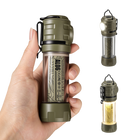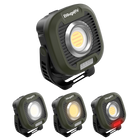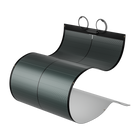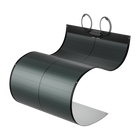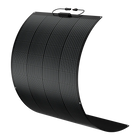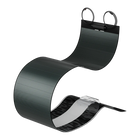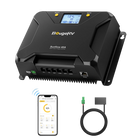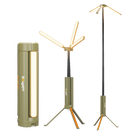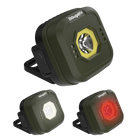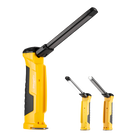What Size Inverter for RV? All You Need to Know!


If you love RVing, you know how important it is to have a reliable power source for your appliances and electronics. Whether you want to watch TV, charge your phone, use a microwave, or run an air conditioner, you need an inverter that can handle the load.
But how do you know what size inverter for RV you need? And what are the features and types of inverters that you should look for?
In this blog post, we will answer all these questions and more. We will explain what an RV inverter is, why you need it, how to choose the right size and type, and what to consider when buying one and more.
By the end of this post, you will have a clear idea of what size inverter is for the RV you need and how to find the best one for your needs.
Let’s dig in!
What Is an RV Inverter? Why Do You Need It?

An RV inverter converts direct current (DC) from your batteries or solar panels into alternating current (AC) that can power your appliances and electronics. It allows you to use your batteries or solar panels as a source of AC power, which is more efficient and eco-friendly than using traditional generators. With an inverter, you have more flexibility and freedom to camp off-grid or boondock without worrying about finding hookups or running out of fuel.
Without an inverter, you might not be able to use many of the devices, such as a TV, a laptop, a coffee maker, a toaster, or a hairdryer, that make your RVing comfortable and enjoyable. Instead, you would also have to rely on propane or gas generators or portable power stations for heating and cooling.
Most RVs have a 12-volt DC system, while most household devices use 120-volt AC.
RV and Camper Inverter Size Calculator

To determine the right size inverter for your RV, you should calculate how many appliances you will run simultaneously. For most RVers, a 2000W or 3000W inverter is enough to power an RV unless you have an unusual number of high-power devices running simultaneously.
To calculate the exact size of the inverter you need, you can follow these steps:
-
Make a list of all the appliances or devices you want to run at the same time and their wattage. You can find the wattage on the label or manual of the device, or use an online wattage calculator.
-
Add up the wattage of all the devices. This is your total wattage.
-
Then, multiply your total wattage by 1.2 to account for power surges or spikes that may occur when some devices start up or shut down. This is your surge wattage.
-
Finally, choose an inverter that has a continuous output rating equal to or higher than your total wattage, and a peak output rating equal to or higher than your surge wattage.
For example, let's say you want to run these appliances on your RV simultaneously:
- TV: 150 watts
- Laptop: 50 watts
- Microwave: 1000 watts
- Coffee maker: 800 watts
Your total wattage is 150 + 50 + 1000 + 800 = 2000 watts.
Your surge wattage is 2000 x 1.2 = 2400 watts.
Therefore, you would need an inverter that has a continuous output rating of at least 2000 watts and a peak output rating of at least 2400 watts. For example, a BougeRV’s 2000W inverter can power the RV in this case.
Can an Inverter Power a Whole RV?
Most inverters can handle small to medium-sized appliances and electronics, such as TVs, laptops, microwaves, coffee makers, fans, lights, etc. With a 2000-watt pure sine wave inverter, you can run most larger RV appliances such as TVs, microwaves, coffee makers, RV refrigerators, toasters, computers, stereos, and ceiling fans.
However, air conditioners, heaters, power-hungry refrigerators, electric stoves, hair dryers, electric kettles, irons, etc., these devices either have high wattage or high surge power that can overload or damage your inverter. They are also not compatible with modified sine wave inverters which can lead to overheating or malfunction.
If you want to power these devices with an inverter, you would need a very large and expensive inverter that can handle their power needs. And you would need a lot of batteries or solar panels to supply enough DC power to the inverter.
How Many Batteries Do You Need?

The more power you use, the faster your batteries will drain and the more often you will have to recharge them. To estimate how much battery storage you'll need to support your inverter and power consumption, follow these steps:
1. Find out the amp-hour (Ah) rating of your batteries. The Ah rating indicates the amount of current a battery can deliver over one hour. For example, a 100 Ah battery can deliver 100 amps for one hour or 50 amps for two hours, and so forth.
2. If you are using a 12-volt battery, divide your total wattage by 12 volts to get the total amps you draw from your batteries. For instance, if your total wattage is 2000 watts, then:
2000 Watts / 12 volts = 166.67 amps. (Amps = watts/volts)
However, to account for the inefficiency of the inverter, which is typically around 85% to 90%, you need to increase this calculated current. Assuming an efficiency of 85%, multiply the amps by the inverse of the efficiency:
166.67 Amps / 0.85 = approximately 196.08 amps.
3. To find out how long your batteries can last at this rate of discharge, divide their Ah rating by the adjusted total amps. Using 100 Ah batteries as an example:
100 Ah / 196.08 Amps ≈ 0.51 hours or approximately 30.6 minutes.
4. Multiply the number of hours by the number of batteries you have to get the total estimated battery life. If you have two 100 Ah batteries, then:
0.51 hours x 2 batteries ≈ 1.02 hours or approximately 61.2 minutes.
If you want to extend your battery life, you can either add more batteries, use batteries with a higher Ah rating, reduce your power consumption, use a portable power station as a battery backup, or a combination of these options.
And it’s worth noting that regularly discharging batteries deeply can significantly shorten their lifespan. So, it's generally recommended to size your battery bank so that you do not exceed 50% depth of discharge (DoD) for lead-acid batteries, or up to 80% DoD for some lithium batteries, during regular usage. This will help ensure a longer life for your battery bank.
Using this guideline, you may need to adjust the number of batteries accordingly based on your specific energy needs and battery type.
What to Look for When Buying an Inverter for RVs?

When buying an inverter for RVs, there are several factors that you should consider, such as:
Size
As we discussed earlier, the size of the inverter you need depends on the wattage of the devices you want to run simultaneously. You should choose an inverter that has enough continuous and peak output ratings to handle your power needs.
Type
There are two main types of inverters: pure sine wave and modified sine wave. We will explain the difference between them in the next section.
Features of Inverters
Some features that you may want to look for in an inverter are:
-
Remote control: This allows you to turn on and off the inverter from a distance without having to access it physically.
-
LCD Display: This shows you the input and output voltage, current, power, and battery status of the inverter.
-
Protection: This includes features such as overload protection, short circuit protection, overheat protection, low voltage alarm, etc. that prevent damage to the inverter and your devices.
-
Efficiency: The higher the efficiency, the less power is wasted and the longer your batteries will last.
-
Warranty: This is the period of time that the manufacturer guarantees the quality and performance of the inverter.
At BougeRV, we offer 1000W, 2000W, and 3000W 12-volt pure sine wave RV inverters for RVs and campers that come with remote control, LCD Display, and protection features. They are high-efficiency and have an 18-month warranty offering you peace of mind. Check out our quality RV inverters to find more details!
Pure Sine Wave vs. Modified Sine Wave Inverters

The type of inverter you choose affects the quality and compatibility of the AC power that it produces.
A pure sine wave inverter produces AC power that is identical or very close to the AC power that you get from a wall outlet or a generator. It has a smooth and continuous waveform that can power any device without any issues.
On the other hand, a modified sine wave inverter produces AC power that is not as smooth or continuous as a pure sine wave. It has a stepped or square waveform that can cause some devices to run less efficiently or not at all.
The Advantages of a Pure Sine Wave Inverters:
-
Compatible with a wider range of appliances and devices.
-
More efficient and quieter than a modified sine wave inverter.
-
Provide smoother electrical output, and reduce interference and noise in sensitive devices such as TVs, laptops, radios, etc.
-
Extends the lifespan of your devices by preventing overheating and damage.
The Disadvantages of Pure Sine Wave Inverters:
-
More expensive than a modified sine wave inverter.
-
Heavier and bulkier than a modified sine wave inverter.
The Advantages of a Modified Sine Wave Inverters:
-
Cheaper than a pure sine wave inverter.
-
Lighter and smaller than a pure sine wave inverter.
The Disadvantages of a Modified Sine Wave Inverters:
-
Cannot power some devices such as air conditioners, heaters, refrigerators, electric stoves, hair dryers, electric kettles, irons, vacuum cleaners, etc.
-
Reduces the efficiency and performance of some devices such as microwaves, coffee makers, fans, lights, etc.
-
Causes interference and noise in some devices such as TVs, laptops, radios, etc.
- Shortens the lifespan of your devices by causing overheating and damage.
Conclusion
In short, selecting the appropriate inverter size is essential for your RV's power needs. Whether opting for a typical 2000W or 3000W inverter or another size, make sure it satisfies your wattage requirements. Review our blog and take into account the considerations mentioned earlier before making your choice.
Head to BougeRV for quality pure sine wave RV inverters and get powered up for your next trip!
FAQs
1. Do You Need an Inverter for Your RV?
If you only use DC appliances or devices that can be plugged into a 12V outlet or a USB port, such as lights, fans, radios, phones, tablets, etc., then you do not need an inverter. However, if you want to use AC appliances or devices that need a standard 120V outlet, such as TVs, microwaves, laptops, coffee makers, etc., then you do need an inverter.
2. Are There Drawbacks to Larger Inverters?
As mentioned above, a larger inverter will draw more power from your batteries and may drain your battery faster. It may also generate more heat and noise and require more ventilation and cooling. Moreover, a larger inverter may cost more upfront and may be harder to install and maintain.
3. Can more than one inverter be used at the same time?
You can use more than one inverter at the same time as long as you have enough batteries and wiring to support them. But, you should use separate outlets or circuits for each inverter and label them accordingly.
4. Is a 2000-watt inverter enough for an RV?
A 2000-watt inverter can provide up to 2000W of continuous power and up to 4000W of surge power. It can run most of the common RV appliances and electronics, such as TVs, laptops, microwaves, coffee makers, etc.
5. What can I run off a 1000W inverter?
A 1000W inverter can run 800W loads such as panel televisions, computers, coffee makers, toasters, refrigerators, gaming devices, TVs, laptops, fans, lights, radios, etc.
However, a 1000W inverter may not be able to run some of the larger or heavier RV appliances like microwaves, hair dryers, air conditioners, etc. These appliances require more power than what a 1000W inverter can provide.
6. Will a 1000-watt inverter run a refrigerator?
A typical RV refrigerator has running wattage of about 150W to 250W and their starting wattage is usually two to three times higher. So, a 1000-watt inverter can run an RV refrigerator.
7. What’s the difference Between RV Inverter vs. Converter?
The inverter and converter are actually two different devices that perform opposite functions. As mentioned earlier, the inverter converts DC to AC. On the other hand, the converters convert AC to DC power that can charge your RV batteries and power some of your DC appliances.
A converter is built into your RV electrical system and doesn’t need any additional installation. An inverter is separately installed and connected to your batteries and your AC outlets.







